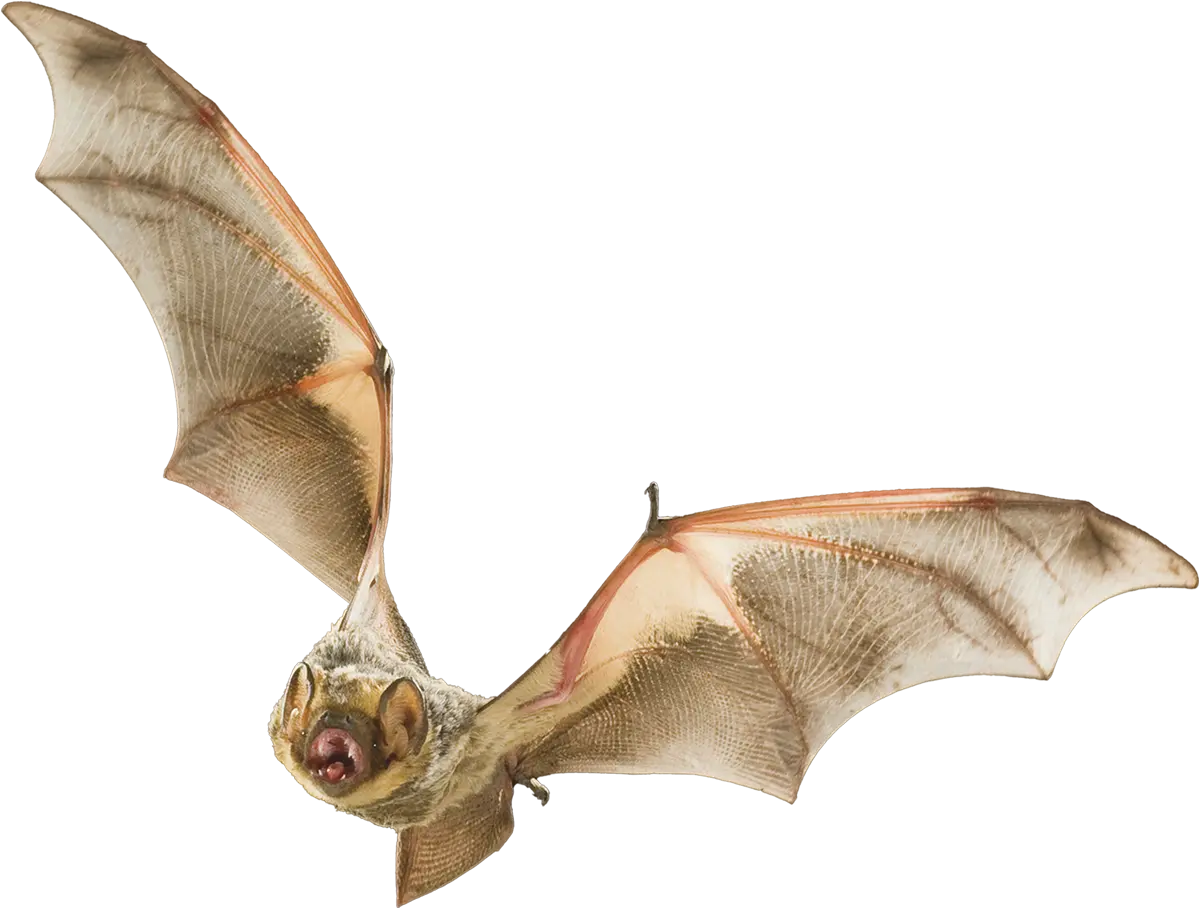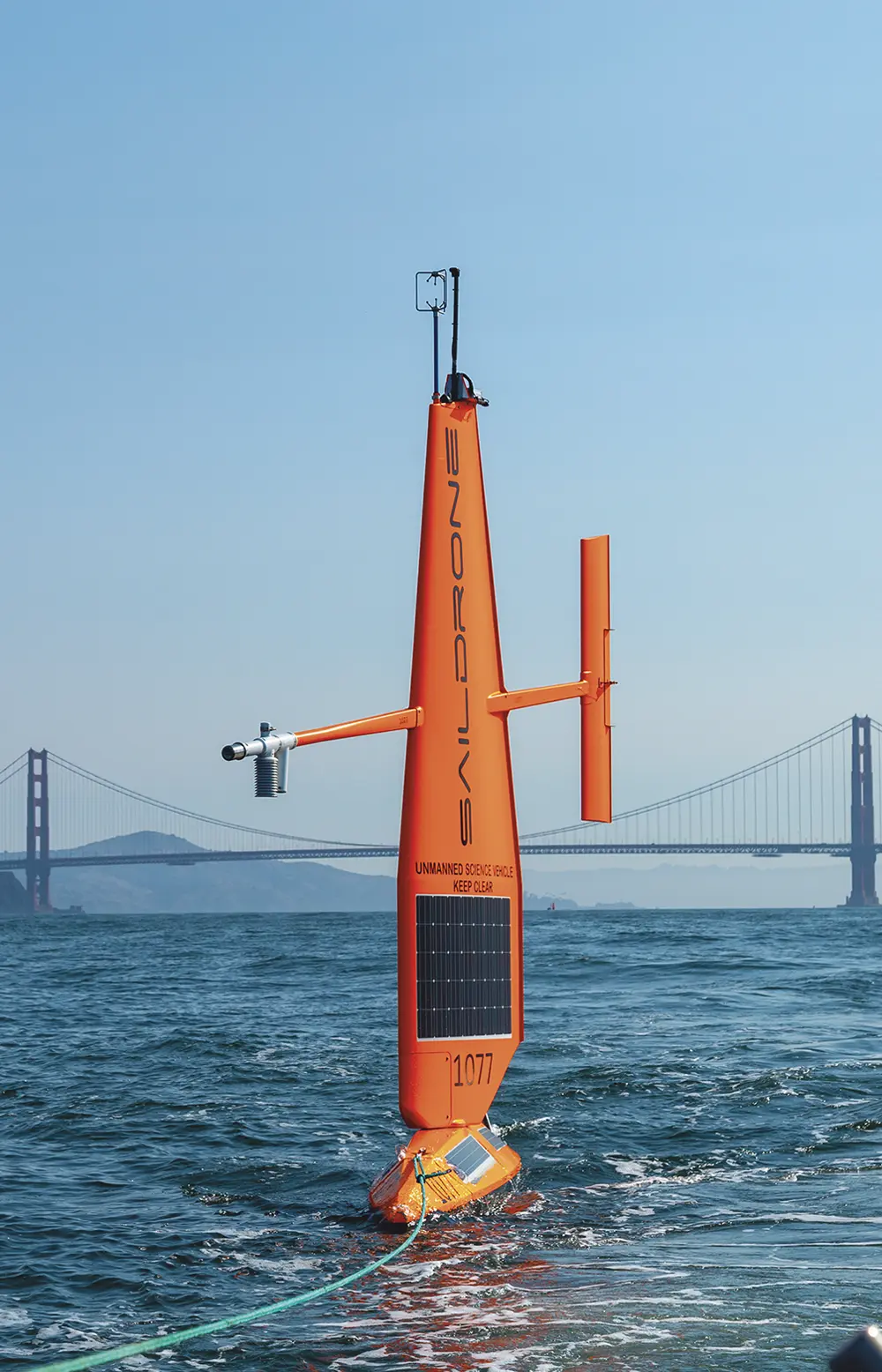 Feature: Saildrone
Feature: SaildroneCharting Bat Migration Along the Pacific Coast


Partnership with Saildrone collects bat data using innovative technology
By Kristen Pope
 BCI and partners mounted a bat detector on a Saildrone autonomous vehicle and launched it near Northern California’s Farallon Islands in August 2023. Sailing offshore, the drone collected bat echolocation data for over a month.
BCI and partners mounted a bat detector on a Saildrone autonomous vehicle and launched it near Northern California’s Farallon Islands in August 2023. Sailing offshore, the drone collected bat echolocation data for over a month.ear Northern California’s Farallon Islands, a hoary bat (Lasiurus cinereus) swooped low over the ocean and emitted an echolocation call. While no humans were nearby to hear it, a bat detector mounted on a Saildrone Explorer autonomous research vehicle recorded the sound, one of hundreds of data points BCI recently collected in a pilot project to assess the viability of collecting bat data offshore using these devices.
—Gabriel Reyes

Saildrone uncrewed surface vehicles were used to record more than 800 bat eholocation calls in a project with BCI.
Courtesy: Saildrone
While BCI’s team studying wind energy and bats has primarily focused on land-based turbines across North America and Europe, this effort will explore areas offshore.
“We don’t know how frequently bat fatalities occur offshore, but we know bats are attracted to and killed by wind turbines on land,” says Michael Whitby, BCI’s Director of Bats and Wind Energy Program. “This study is to determine if offshore wind energy threatens bats.”
To study bats in the offshore environment of California, BCI teamed up with Saildrone, which uses autonomous marine vehicles powered by wind and solar to collect in-depth ocean data. Saildrone’s vehicles have been used in harsh environments, such as circumnavigating Antarctica and sailing into the eye of a hurricane, to collect data, so the BCI team wanted to see if the vehicles could be used to collect bat echolocation data offshore. They mounted a Wildlife Acoustics SM4 bat detector and microphone on the 16-foot mast of a Saildrone Explorer. The vehicle was launched in late August and collected data near Northern California’s Farallon Islands from Sept. 1 to Oct. 4, 2023.
Once the vehicle was brought safely to shore, scientists found the detector recorded 1,375 files. Many were noise, which is standard for bat acoustic surveys, but they used SonoBat software to differentiate 831 bat echolocation calls from at least four species of bats. They detected 164 calls from Mexican free-tailed bats (Tadarida brasiliensis), 111 from hoary bats (Lasiurus cinereus), 48 from silver-haired bats (Lasionycteris noctivagans), and 15 from big brown bats (Eptesicus fuscus), along with a large number of bat calls that could not be linked to a particular species, which is common with acoustic surveys.
—Michael Whitby

Bat detector weatherized against harsh offshore conditions and ready for deployment.
Photo: Gabe Reyes, USGS
Bats’ echolocation calls can provide clues that go beyond the species. While bats forage in open areas with longer calls of lower frequencies, they emit short, high-frequency pings to identify nearby objects. Bats are known to land on ships and unknown structures, so the shape of the call patterns leads Whitby to believe they may have been checking out the vehicle. “The majority of calls we recorded were shaped like calls a bat would make in a close, narrow environment, so we think the bats were investigating the Saildrone,” Whitby says.
Collecting hard-to-reach data
Collecting offshore data is challenging. Buoys are commonly used for sampling, though there are a limited number of weather buoys available to affix a bat detector to, and many of these are located outside of areas where wind energy development is focused.
Another option is to place a detector on a ship. Sometimes, researchers can affix a detector to a “ship of opportunity,” any vessel that allows them to attach a bat detector. Still, they have no control over where the ship goes, creating an opportunistic sample. Hiring a ship for data collection is another option, but expensive. Researchers were excited to explore the possibility of a Saildrone vehicle providing a new method for data collection.
Bat Detection Aboard an Uncrewed Seafaring Vehicle
Using waterproof marine-grade tape, BCI, Saildrone, and partners mounted an acoustic bat detector (SM4Bat by Wildlife Acoustics, Inc.) atop a Saildrone Explorer. The microphone was mounted on a 3-foot mast above the 16-foot-tall sail. The climate-friendly technology is solar and wind-powered, and the Saildrone Explorer is the first autonomously operated marine vehicle launched to monitor bat sounds off the coast of California.

A hoary bat is roosting on the outside of a tree.

Photo: Michael Durham/Minden Pictures
Hoary Bats at Risk
Hoary bats are one species of exceptionally high conservation concern due to how frequently wind turbines kill them across North America. BCI research found that land-based wind energy has the potential to cause a more than 50% decline in the species by 2050.
At first, researchers were nervous about whether the bat detector would withstand harsh sea conditions, but it performed well and still collected data when brought ashore. Researchers considered adding more than one detector for redundancy, but the team didn’t want to add more weight to the finely tuned vehicle.
The team steered the vehicle remotely, keeping it near the Farallon Islands. The survey focused on the southeastern side of one island where a cluster of three trees had roosting hoary bats, which have been spotted there for decades. They wanted the vehicle to go near to see if they could pick up calls from the bats to test the concept—and it did a great job recording these calls.
Part of a larger effort
The ongoing effort to collect baseline bat data from over the ocean grew from the Bureau of Ocean Energy Management’s (BOEM) interest in better understanding the risks bats face during seasonal coastal migrations as wind energy expands. The BOEM-funded project enabled USGS scientists to collect acoustic data from offshore sites.
—Michael Whitby
Their work requires collecting bat data from detectors mounted everywhere, from remote lighthouses and offshore rocks to small islands requiring access to a boat. For years, the duo has scrambled up sketchy outcroppings and used helicopters to reach far-flung monitoring sites. Since their ongoing study needs easier access to more distant migratory sites miles offshore, they have been soliciting outside help in the form of scientific ships, research cruises, and innovative technology to get farther out into the open ocean. They knew linking up with groups outside their initial research scope would help expand their sampling range.

“We’re trying to get to sites that are miles offshore,” says Reyes. “Having the Saildrone pilot trial was a neat option.”
BCI and collaborators are working on a larger study, set to begin this spring, that will involve two years of sampling using a variety of methods, including weather buoys, onshore detectors, island-mounted detectors, lighthouses, ships of opportunity, and potentially further collaboration with Saildrone.
Meeting renewable energy goals with fewer bat fatalities
Studies have already shown that wind turbine strategies such as curtailment (preventing turbines from spinning during high-risk periods), operational changes, and raising the cut-in speed of turbines (the wind speed at which turbines become operational) can reduce bat fatalities onshore by 50% with a 1% loss in annual energy production. Researchers hope collecting more data about offshore bats can help implement climate-friendly energy solutions and boost bat conservation.
“There are ways to meet renewable energy goals with fewer bat fatalities,” Whitby says. “So, finding and implementing these ways is extremely rewarding because we can find win-win solutions for renewable energy generation and bat conservation.”